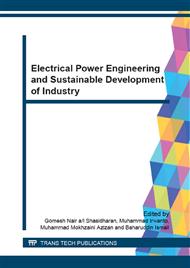[1]
N. Thouault*, C. Breitsamter*, Jost Seifert*, C. Badalamenti§, S.A. Prince§ and N.A. Adams*, NUMERICAL ANALYSIS OF A ROTATING CYLINDER WITH SPANWISE DISCS, 27 International congress of the aeronautical sciences (ICAS2010).
DOI: 10.2514/1.j050856
Google Scholar
[2]
Mittal, S., and Kumar, B. Flow past a rotating cylinder. Journal of Fluid Mechanics, 476 (2003), p.303–334.
DOI: 10.1017/s0022112002002938
Google Scholar
[3]
Theodorsen, T., and Regier, A. Experiments on drag of revolving discs, cylinders and streamline rods at high speeds. NACA Report 793, (1944).
Google Scholar
[4]
Y. -R. Ou, J. A. Burns , Optimal control of lift/drag ratios on a rotating cylinder, Institute for Computer Applications in Science and Engineering, NASA-Langley Research Center, Hampton, VA 23665, U.S.A. Appl. Math. Lett. Vol. 5, No. 3, pp.57-62, (1992).
DOI: 10.1016/0893-9659(92)90040-g
Google Scholar
[5]
Azharrudin A, Mohammad Rizal R, Halim A, Preliminary study towards the manufacturing of a rotating cylinder surface as a lift generator, ICAM, (2011).
Google Scholar
[6]
Y. -R. Ou, Active control of flow around a rotating cylinder, Presented at the Meeling on Turbulence Stucture and Control, Co-sponsored by AFOSR and Ohio State University, Columbus, April 13, (1991).
Google Scholar
[7]
Smits, A.J. A new aerodynamic model of a golf ball in flight. In A.J. Cochran and M.R. Farrally, (eds. ), Science and Golf II, p.340–347. E&FN Spon, (1994).
Google Scholar
[8]
John D. Anderson, Fundamentals of Aerodynamics, McGraw-Hill, New York, (2001).
Google Scholar
[9]
Reid, E.G. Tests of rotating cylinders. NACA Technical Note, NACA-TN-209, (1924).
Google Scholar
[10]
Childs, P.R.N. Mechanical design. 2nd Edition. Elsevier, (2004).
Google Scholar
[11]
Thom, A. Effects of discs on the air forces on a rotating cylinder. Aeronautical Research Committee Reports and Memoranda 1623, (1934).
Google Scholar
[12]
Sridhar Muddada, B.S.V. Patnaik, An active flow control strategy for the suppression of vortex structures behind a circular cylinder, European Journal of Mechanics - B/Fluids Volume 29, Issue 2, March–April 2010, Pages 93–104.
DOI: 10.1016/j.euromechflu.2009.11.002
Google Scholar
[13]
Azharrudin Asrokin, Mohammad Rizal Ramly, Rotating cylinder design as a lifting generator, IOP Conference Series: Material Science and Engineering-50 (2013) 012025.
DOI: 10.1088/1757-899x/50/1/012025
Google Scholar


